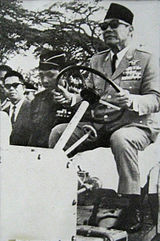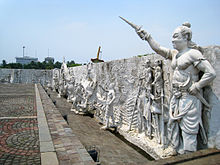- National Monument (Indonesia)
-
Coordinates: 6°10′31.45″S 106°49′37.61″E / 6.1754028°S 106.8271139°E
- "Monas" redirects here. In scientific nomenclature, -monas (meaning "unicellular") is a suffix for bacterial genera or Monas (genus), a protist
Monumen Nasional 
Monumen NasionalGeneral information Type Obelisk Monument Location Central Jakarta, Indonesia Construction started 17 August 1961 Inaugurated 12 July 1975 Height 132m Design and construction Client Government of Indonesia Owner Republic of Indonesia Main contractor P.N. Adhi Karya
(foundation piles)Architect Frederich Silaban,
R.M. SoedarsonoThe National Monument (Indonesian: Monumen Nasional (Monas)) is a 433 ft (132 metre) tower in the centre of Merdeka Square, Central Jakarta, symbolizing the fight for Indonesia's independence. Construction began in 1961 under the direction of President Sukarno and the monument was opened to the public in 1975. It is topped by a flame covered with gold foil. The monument and the museum is open daily from 08.00 - 15.00 Western Indonesia Time (UTC+7), everyday throughout the week, except for the last Monday of each month, when the monument is closed.
Contents
Background
After the Indonesian government returned to Jakarta from Yogyakarta in 1950 following the Dutch recognition of Indonesian independence, President Sukarno began to contemplate the construction of a national monument comparable to the Eiffel Tower on the square in front of the Presidential Palace. On 17 August 1954, a National Monument Committee was established and a design competition was held in 1955. This attracted 51 entries, but only one design, by Frederich Silaban, met any of the criteria determined by the committee, which included reflecting the character of Indonesia in a building capable of lasting for centuries. A repeat competition was held in 1960, but once again, none of the 136 entries met the criteria. The chairman of the jury team then asked Silaban to show his design to Sukarno. However, Sukarno did not like the design as he wanted the monument to be in the form of a linga and yoni. Silaban was asked to design such a monument, but his design was for a monument so large that it would have been unaffordable given the economic conditions at the time. Silaban refused to design a smaller monument, suggesting that construction be delayed until the Indonesian economy improved. Sukarno then asked the architect R.M. Soedarsono to continue with the design. Soedarsono incorporated the numbers 17, 8 and 45, representing the 17 August 1945 Proclamation of Indonesian Independence, in the dimensions of the monument.[1][2][3]
Construction
Construction proceeded in three stages. The first period, from 1961/1962–1964/1965 began with the official start of construction on 17 August 1961 with Sukarno ceremonially driving in the first concrete pile. A total of 284 piles were used for the foundation block. A further 360 piles were driven in for the museum foundations, with work being completed in March 1962. The walls of the museum in the base were completed by October. Construction of the obelisk than commenced and was finished in August 1963. Work in the second stage, from 1966 to 1968 was delayed by shortages of funding and the aftermath of the 30 September Movement coup attempt. In the final phase, from 1969–1976, the dioramas for the historical museum were added. Problems remained once construction was complete, and work was needed to solve problems with water leaking into the museum. The monument was officially opened to the public on 12 July 1975.[4][5] The location of the construction site is known as Merdeka Square.
Monument design
The towering monument encapsulates the philosophy of Lingga and Yoni. Lingga resembles an alu rice pestle and Yoni resembles a lesung rice mortar, two important traditional Indonesian tools. Lingga and Yoni also symbolize eternal life with the lingga phallic symbol, representing masculinity, positive elements, and daytime and the Yoni the female organs symbol, representing femininity, negative elements, and night. The monument consists of a 117.7m obelisk on a 45m square platform at a height of 17m, the goblet yard. The obelisk itself is clad with Italian marble.[6][7]
The northern pond measuring 25×25 m was designed to cool water for the air conditioning system in the monument as well as to enhance the beauty of the surrounding area. To the north of the monument, there is a statue of Indonesia national hero Prince Diponegoro by Italian sculptor Cobertaldo.[8] The entrance to the monument is located at the Medan Merdeka Utara or Northern Merdeka Park, through the underground tunnel visitors will reach the northern side of the monument. The ticket office is located at the end of the tunnel. When visitors resurface in northern side of the monument, visitors could took a round trip outside the monument to see reliefs of Indonesian history; continued to National History Museum at the base on northeastern corner, or continued straight to the centre of the monument towards Hall of Independence or elevator.
Reliefs of Indonesian History
High reliefs of Indonesian history depicting Gajah Mada and Majapahit history
On the outer yard encircling the monument, on each four corners, there are high reliefs of Indonesian History. The story begins in the northeastern corner, and describes the ancient glory of the Indonesian archipelago, featuring ancient history especially that of Singhasari and Majapahit. The relief continues to the southeast, southwest, and northwest corners, chronologically displaying European colonialization of the Indonesian archipelago, popular local uprisings, modern Indonesian organization in the early 20th century, the Japanese occupation in World War II, the Proclamation of Independence, the Indonesian National Revolution and post-independence develelopments. The reliefs and statues were made from molded cement, but several of these statues are already damaged and have decayed due to torrential rain and the tropical climate.
The National History Museum
Inside the base of the monument there is the Indonesian National History Museum, located three metres below the surface of the monument. It is a large marble-lined room measuring 80 x 80 metres with 48 dioramas along the walls side depicting scenes from the Indonesian history from prehistory until the New Order, plus 3 other dioramas in the center of the room, making a total of 51 dioramas. The dioramas begin at the northeast corner, and show the history of Indonesia; from prehistory, the era of ancient kingdoms such as Srivijaya and Majapahit, followed by European colonialization and local uprisings against the VOC and Dutch East Indies rule. The dioramas continue well into the 20th century, Japanese occupation, Indonesian independence proclamation in 1945, to the struggle for independence of Indonesian revolution, and on to the New Order era of Suharto's regime.
The Hall of Independence
Inside the goblet or "cup" part of the monument, there is the Hall of Independence (Indonesian: Ruang Kemerdekaan) shaped like an . The hall is accessible through spiral stairs at the north and south doors. It contains symbols of Indonesian independence and nationhood, including the original text of the Proclamation of Independence in a glass case, the coat of arms of Indonesia, and a map of the Indonesian archipelago in gold.[1][9] The original text of Indonesian proclamation of independence is stored in a glass case inside the golden door on the west side of inner-wall clad in black marble. The mechanized bronze doors weigh 4 tons, and are coated with gold adorned with the image of awijaya kusuma flower, symbolizing eternity, and a lotus flower, symbolizing purity. The doors known as Gerbang Kemerdekaan or the Gate of Independence and are opened slowly using a mechanism while the nationalist Padamu Negeri song plays, followed by a recording of Sukarno reading the text of the Proclamation. On southern side wall there is a large statue of Garuda Pancasila, the coat of arms of Indonesia, made from 3.5 tons of bronze coated with gold. On eastern side there is the text of the proclamation in bronze lettering. Originally the eastern side displayed the most sacred Indonesian flag, Sang Saka Merah Putih, originally raised on 17 August 1945. However because it is fragile and in poor condition, it is no longer displayed. The northern side wall displays a map of the Indonesian archipelago coated in gold.
The Peak Platform Observation deck and Flame of Independence
A lift on the southern side carries visitors to the 11 metre by 11 metre viewing platform, at a height of 115 metres. The capacity of the elevator is about 11 people. The top platform can accommodate about 50 people, and also provided with binoculars. There is also a staircase for use in emergencies. The total height of the monument is 132 metres. The distance from the viewing platform to the tip of the flame is 17 metres. The ticket to top platform is Rp.7,500 for adult at beginning of January 2011.
The monument is topped by a 14.5 ton bronze Flame of Independence containing the lift engine. The base of the flame where the elevator door is located is 3 metres high and is in the shape of a goblet. The bronze flame structure measures 14 metres in height and 6 metres in diameter, It consists of 77 sections bound together. Originally the bronze flame structure was covered with 35 kg[1] of gold foil, however during the 50th anniversary of Indonesian independence in 1995, the gold foil was recoated and increased to 50 kg[10] gold foil. The obelisk and flame symbolize the Indonesia people's struggle for independence. The middle platform on top of the cawan (goblet) provides visitor with views of the surroundings from a height of 17 metres. The goblet yard is accessible through elevator on the way down or through the stairs.
Gallery
-
Prithvi statue and high reliefs surrounding Monas.
References
- Heuken, A, (2008) Medan Merdeka - Jantung Ibukota RI (Merdeka Square - Heart of the Indonesian Capital), Yayasan Cipta Loka Caraka, Jakarta, No ISBN (Indonesian)
- Jakarta Local Government website: Museums in Jakarta (Indonesian)
- National Monument Office, Jakarta Capital City Administration (1996), National Monument: The Monument of the Indonesian National Struggle ISBN 979-95172-0-6
Notes
- ^ a b c Heuken (2008) p25
- ^ National monument Office, Jakarta (1996) pp. 3-9
- ^ The height of the goblet yard at the base of the plinth is 17m, the width of the plinth at the base is 8m and the width of the goblet yard is 45m
- ^ National monument Office, Jakarta (1996) pp. 12-23
- ^ Jakarta Administration website
- ^ Monument Nasional brochure; Dinas Pariwisata dan Kebudayaan Provinsi DKI Jakarta, Unit Pengelola Monumen Nasional
- ^ National monument Office, Jakarta (1996) p. 5
- ^ National monument Office, Jakarta (1996) pp. 28-29
- ^ National monument Office, Jakarta (1996) pp. 24-28
- ^ National monument Office, Jakarta (1996) p28
Categories:- Buildings and structures in Jakarta
- Towers in Indonesia
- Buildings and structures completed in 1975
- Monuments and memorials in Indonesia
- Post independence architecture of Indonesia
Wikimedia Foundation. 2010.
















